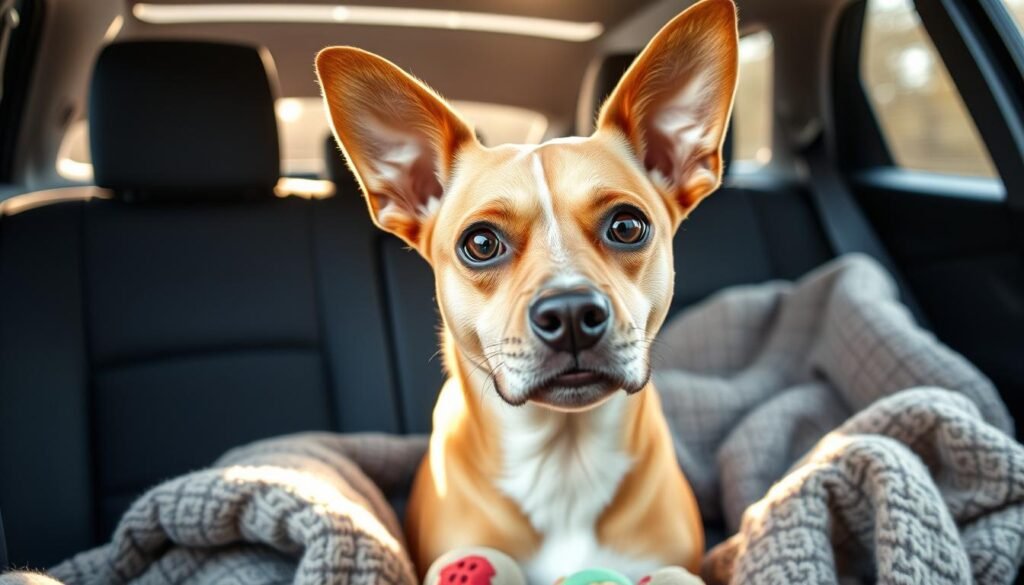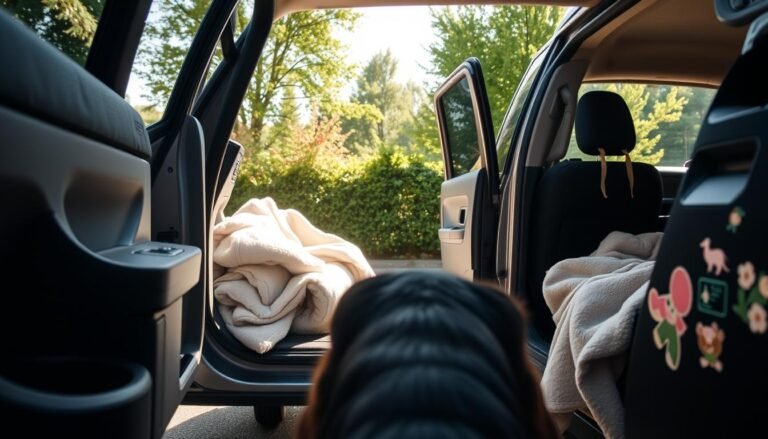Going on a scenic road trip with your pet should be perfect. But for many dogs, car rides are scary. Why do dogs get anxious at the sight of a car? How can you use dog car training techniques to make trips easy?
Dogs, like humans, can have fears, and cars are one of them. But don’t worry! Changing canine car ride anxiety into fun trips is easier than you think. This article will show you how to make your dog’s car rides happy and stress-free.
Let’s explore canine car ride anxiety solutions together. You’ll learn to make your car a safe space for your dog. Soon, your dog will love getting into the car, ready for any adventure. Let’s turn their fear into excitement, step by step.
Quick Recommendation. Our blog is filled with tips and tricks for training your puppy or dog. If you’re seeking a comprehensive online training program, we recommend K9 Training Institute.
Understanding Your Dog’s Car Anxiety
Watching your dog’s behavior in the car can tell you a lot about their comfort and stress. Dogs often show signs of stress like whining, panting, and shaking. These signs can get worse if not handled right.

Figuring out why your dog is anxious is key to helping them feel better in the car. Some dogs are scared because of bad past experiences or because the car feels scary. Changes in their routine or environment can also upset them.
In this part, we’ll look closer at what makes dogs anxious in cars and how to spot early stress signs. You might notice your dog is scared of the car’s small space, the engine noise, or how it moves. These are common things that can make dogs anxious.
Knowing these signs and triggers helps you change your dog’s car experience for the better. We’ll share ways to reduce these stressors in the next parts.
Preparing for the First Car Ride
Starting your dog’s first car ride can be nerve-wracking. But with the right dog car ride preparation, it can be a fun experience for both. Using positive reinforcement in dog training is key to a successful first ride.
Choose a calm time for the ride, like after eating or a walk. This helps your dog feel ready for the new experience. Bringing their favorite treats or toys can make the car feel more welcoming.
Keep the first ride short, around 5 to 10 minutes. This lets your dog get used to the car without feeling too stressed. Use positive reinforcement by giving treats and praise for good behavior. This makes car rides something to look forward to.

The first ride is about getting your dog used to car travel, not just reaching a destination. Be patient and consistent. With good dog car ride preparation and positive reinforcement in dog training, your dog will soon love car rides as much as home.
Creating a Safe and Welcoming Environment in Your Car
Ensuring dog car safety and comfortable dog travel starts with the right environment in your vehicle. It’s not just about minimizing stress; it’s also about safeguarding your furry friend on every trip. A secure and inviting space not only enhances safety but also helps in making your dog feel at ease, even during long journeys.

Firstly, opt for a crash-tested harness or a pet carrier that’s appropriate for the size and weight of your dog. These restraint systems prevent injury by keeping your dog stable in the event of sudden stops or turns. Additionally, they assist in maintaining your focus on driving without distractions.
Next, enhance the comfort of your dog by adding a blanket or a bed from home in the car. This familiar scent can have a calming effect, reducing anxiety during transit. Integrating comforting items from home is a simple yet effective strategy for comfortable dog travel.
Remember, creating a safe and welcoming environment goes beyond physical adjustments. It’s about making every journey stress-free and enjoyable for both you and your pet, reinforcing positive associations with car rides.
Quick Recommendation. Our blog is filled with tips and tricks for training your puppy or dog. If you’re seeking a comprehensive online training program, we recommend K9 Training Institute.
Introducing Your Dog to the Vehicle
When introducing your dog to the car for the first time, aim for a stress-free experience. This will help ease your dog into the car smoothly. Begin by letting your dog sniff around the parked car under your watchful eye.
This slow exploration helps your dog get used to the car’s smell and presence. It avoids the pressure of an immediate ride.

Then, encourage your dog to get closer to the car. Use treats or their favorite toys to help them. It’s important to stay calm and cheerful during these steps.
Once your dog is inside, spend time with them, offering treats or comfort. This helps build positive associations with the car.
Remember, patience is key. If your dog seems stressed or hesitant, give them more time or try again another day. Each positive interaction with the car builds their confidence for future trips.
Gradual Desensitization: Step-by-Step Car Training
Starting desensitization techniques for dogs around car travel needs patience and effort. We’ll look at a step-by-step dog training method. It aims to help your dog get over their car ride anxiety.
The first step is getting your dog used to the car. Park the car and let your dog get comfortable inside. Sit with them, giving treats and comfort, to make it a positive experience. The time spent here can vary based on your dog’s anxiety.

When your dog feels okay in the car, it’s time for short drives. Start with small trips like driving down the driveway or around the block. Keep the atmosphere calm and rewarding. Praise and treat your dog for staying calm.
Slowly increase the length and distance of the car rides. Each good experience builds your dog’s confidence. Keep using treats and praise to encourage good behavior. Always consider your pet’s comfort and reactions.
Watch your dog’s behavior closely during desensitization. If they show stress, slow down and go back to a previous comfortable level. This ensures their safety and well-being.
Desensitization is more than just exposing your dog to cars. It’s about making each step a positive experience. With dedication, your dog will not only tolerate but enjoy car rides.
Tackling Motion Sickness in Dogs
If your dog starts whining or drooling at the thought of a car ride, they might be sick. It’s important to prevent car sickness in dogs. This way, you and your pet can enjoy trips together, whether it’s a short drive or a long vacation.
First, know the signs of motion sickness in dogs. They might drool a lot, seem tired, or even vomit. If your dog shows these signs often during car rides, it’s not just nerves or excitement. It’s time to tackle dog motion sickness to make car rides better for your pet.
To fight motion sickness, try a few things. Make sure your dog faces forward while driving. This helps their inner ear balance. Also, don’t feed your dog too much before a trip and keep the car well-ventilated. Taking breaks during long drives can also help.
If your dog’s motion sickness is severe, see a vet. They can give medicines to help and teach you how to condition your dog. Ginger is also a natural way to ease nausea in dogs. Adding a bit of ginger to their food before a trip can help prevent motion sickness.
Preventing car sickness in dogs makes trips more enjoyable for both of you. With the right steps, you can help your dog feel better during car rides. This way, you’ll have many happy miles together.
Behavioral Training to Alleviate Fear and Stress
There are many ways to help your dog feel better in cars. Teaching basic obedience is key. Commands like ‘sit’, ‘stay’, or ‘lie down’ can really help manage your dog’s behavior in a moving vehicle.
Using calming techniques is also important. Playing calming music or using pheromone diffusers before and during the ride can reduce anxiety. This makes the car ride a more peaceful place for your pet.
Positive reinforcement is another crucial part of canine behavioral training. Rewarding your dog for calm behavior or for riding well without stress encourages good behavior. This makes training more fun and effective for both you and your pet.
Consistent practice is vital. Regular, short car trips can help your dog get used to the car’s motion and sounds. Each positive car ride experience builds on the last, making your dog more relaxed and comfortable on trips.
By using these strategies, car rides can become a positive experience for you and your furry friend. What was once stressful can become an enjoyable adventure.
Conducting Regular Car Ride Practice
It’s key to make consistent dog car travel practice a habit when habituating dogs to car rides. Regular trips help your dog get used to car rides and lower their anxiety. Think of these sessions as a routine that makes car rides normal for them.
Begin with short trips around your neighborhood. Keep these trips calm and simple to avoid overwhelming your dog. As they get more comfortable, you can make the trips longer. Remember, repetition and positivity are the keys to success in habituation.
Watch how your dog reacts during these drives and adjust the frequency as needed. Some dogs adapt fast, while others need more time. Make each trip fun and stress-free. Include their favorite toys or treats to make car travel a positive experience.
By making car rides a regular part of your routine, your dog will learn to enjoy them. It’s all about being consistent, making them comfortable, and turning car travel into a fun experience for your furry friend.
Conclusion
Learning to travel with your dog in the car takes time and effort. But the joy of having fun rides together makes it all worth it. We’ve shared important tips to make your car trips better for both you and your dog.
Creating a cozy car space, handling motion sickness, and practicing car rides are key. These steps can make a big difference in your dog’s comfort while traveling. Keep an eye on how your dog reacts and adjust your plans as needed.
Consistency is the secret to making car travel smooth for your dog. Every step you take helps reduce their stress. With patience and the right training, you’ll have many happy trips ahead. Imagine the fun of exploring new places with your happy dog by your side.
Quick Recommendation. Our blog is filled with tips and tricks for training your puppy or dog. If you’re seeking a comprehensive online training program, we recommend K9 Training Institute.

